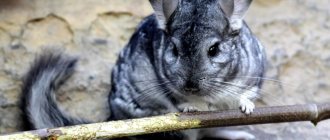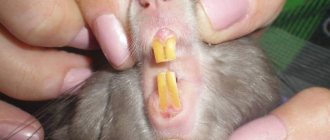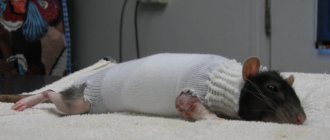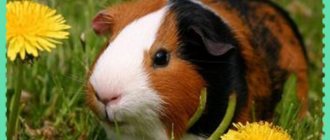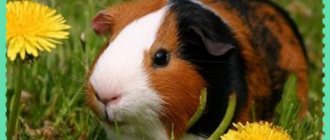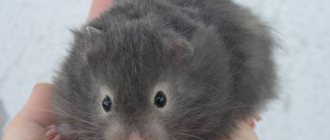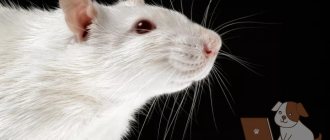- home
- Chinchilla
- Health
03/21/2019 The little chinchilla pleases its owners with its cheerfulness and funny character. But she also has problems. They can relate to such an unpleasant phenomenon as convulsions. It is important to learn how to provide first aid to your pet if there are signs of illness.
Other causes of cold symptoms
Not only colds in chinchillas provoke sneezing, watery eyes and a runny nose. Sometimes things can be much more serious.
Respiratory system diseases
If a chinchilla's cold is neglected or left untreated, it can lead to complications in the respiratory system. These include:
They are often caused by a secondary streptococcal or staphylococcal infection. Diseases of the respiratory system pose a serious danger to both young and adult individuals. If treatment is not done in a timely manner, there is a risk of death, so you should consult a doctor promptly and begin therapy. To treat such ailments, antibiotics are used, which are given in tablets or injected intramuscularly.
Symptoms of bronchopneumonia are:
- frequent cough;
- wheezing and difficulty breathing;
- high temperature;
- apathy.
For this disease, in addition to antibiotics, expectorants, food containing vitamin C and keeping the animal warm are prescribed.
Pneumonia usually develops in newborns born in the summer or autumn. The disease is provoked by a secondary infection, and the symptoms are similar to bronchopneumonia. Antibiotics, probiotics and a vitamin complex are prescribed as therapy to help support the immune system.
Under the wrong conditions, chinchillas can develop hyperthermic changes in the lungs, leading to overflow of the pulmonary vessels with blood. In this case, the rodent experiences suffocation, shortness of breath, rapid pulse, hoarse cough and foamy nasal discharge mixed with blood.
Since hyperemia is often caused by overheating, to eliminate it it is necessary to place the rodent in an optimal environment, and only then begin to eliminate the symptoms. If the chinchilla is overheated, it should be doused with cool water, given some heart drops and a diuretic. And if complications arise, antibiotics will need to be administered, but first the animal must be shown to a doctor to confirm the diagnosis.
Conjunctivitis
Poor maintenance can cause animals' eyes to become clogged with dust or irritated by mold spores. Conjunctivitis can be either mechanical or infectious. With mechanical damage, a speck of dust gets into the eye and the animal’s tears begin to flow.
Interesting! Tears are a protective mechanism against mechanical irritants of the eyes.
What to do if your chinchilla's eyes are watery:
- check for debris under the eyelids;
- rinse eyes with saline solution;
- apply antibiotic drops.
If there are no specks, but your eyes continue to water, this is most likely the beginning of an infectious disease. In this case, it is better to go to the veterinarian to find out the reasons, while the inflammation is still weak and the eye has not festered.
A more severe form of conjunctivitis is purulent.
Very often this is a sign of a general infectious disease resulting from hypothermia and weakened immunity. Local diseases caused by pathogenic microorganisms include inflammation of the lacrimal canal. This disease is usually closely related to the malposition of molars. If an animal constantly develops hooks on its back teeth, you must be prepared that sooner or later the tear duct will also be blocked.
On a note! When the tear duct becomes inflamed, not only the eye festers; purulent discharge also appears from the animal’s nose.
What to do if a chinchilla’s eye festers:
- Before examining the veterinarian, carefully wipe the animal’s eyes with a decoction of calendula, chamomile or other suitable infusion;
- go to the veterinary clinic to determine the cause of the disease;
- follow your doctor's recommendations.
Self-medication here can only do harm, since in case of a general illness it is not the symptoms that need to be treated, but the cause. And if the tear duct is clogged, it will be difficult for the chinchilla breeder to clear it due to the small size of the animal. In addition, tooth extraction may be required.
What does a healthy chinchilla look like? Symptoms of ill health
You need to pay attention to the following points
Behavior
A healthy animal is always active and mobile. If the animal does not move or limps, you need to urgently seek help from a veterinary hospital.
Appetite
Lack of appetite indicates some disease. A chinchilla may have dental problems, oral injuries, or malaise. When stressed, the animal also loses its appetite. Sometimes a deterioration in appetite is observed when changing the usual diet.
Weight
If your pet is losing weight, this may indicate a medical condition. Weight gain in a female may indicate pregnancy.
Excreta
The droppings should be in the form of small dark brown sausages, hard, in normal quantities. Soft droppings may indicate the possible onset of diarrhea, while a small amount of feces may indicate the onset of constipation. Mucus in droppings is a sign of an intestinal infection. Changes in the color of urine and the presence of blood in the urine are a reason to visit the veterinarian.
Genital area
A healthy animal has clean, pink skin in the genital area. There should be no allocations. Skin contaminated with feces is a consequence of diarrhea. If you fed your shushik as usual, without changing your usual diet, and the cause of diarrhea is not related to poor diet, you should urgently go to the veterinary clinic for a stool test and treatment. In males, you need to check the genital area more often in order to notice the appearance of a hair ring in time.
Nipples
The nipples of animals are quite difficult to detect. Well expressed only in pregnant and lactating females: they are easily detected by palpation, soft, pink. If the nipples have changed appearance, this may indicate mastitis, which requires the intervention of a veterinarian.
Stomach
The belly of a healthy animal is soft and warm. A hard belly may indicate poor nutrition or poisoning. In this case, the pet needs treatment.
Skin covering
The skin is normally pink and smooth. To check the skin, blow on the fur or spread it with your fingers. Redness or dandruff may indicate the presence of a fungal disease. Referral to a specialist is required.
Eyes
The eyes should be shiny, clear, dry, without discharge. The fur around the eyes is normally dry and clean, without bare areas.
Nose
The animal's nose area should be dry and clean, without discharge. The appearance of fluid in their nasal passages, especially yellow or green in color, indicates respiratory disease. This situation requires urgent intervention from a veterinarian.
Teeth
A healthy chinchilla's teeth are yellow or orange, of normal length and without bite distortion.
For preventive purposes, it is imperative to consult a veterinary clinic once or twice a year with a mandatory stool analysis and checking the condition of the animal’s molars.
If various signs of the disease appear, you should immediately seek help from a specialist to establish a diagnosis and prescribe treatment.
Chinchilla owners simply need to know the symptoms and methods of treating the main diseases of their pets. To summarize, he will note what deviations in the behavior and well-being of a chinchilla should make you wary and become a reason to contact a veterinarian.
Rectal prolapse
The disease is often a consequence of constipation and the animal’s attempts to cough or very intense diarrhea. This picture looks creepy: 1-2 cm of bloody rectum falls out of the chinchilla’s anus. If measures are not taken immediately, the intestine dries out in the air and the disease ends in tissue necrosis.
The intestine must be immediately lubricated with antibiotic ointment to prevent drying out and infection by pathogenic microorganisms. After which the animal is taken to the veterinary clinic. It is better if the chinchilla’s intestine is corrected by an experienced doctor.
How to deal with hair loss in chinchillas
As soon as it is noticed that your pet’s hair is falling out rapidly, or bald patches have appeared on the body, you need to identify the probable causes and immediately begin to deal with it.
The set of measures aimed at preventing hair loss in animals includes:
- treatment with drugs prescribed by a veterinarian;
- elimination of factors that provoke an allergic reaction;
- introduction of fruits, vegetables and herbs to the nutrition menu;
- soldering the animal with vitamin and mineral supplements;
- improving the indoor microclimate;
- prevention and destruction of ectoparasites.
If you treat the animal carefully and start treatment on time, you can deal with the problem quickly.
Hooks on teeth
These formations usually occur due to a malocclusion, when the teeth meet at the wrong angle. The disease is usually genetic.
Important! Chinchillas with malocclusion should not be allowed to be bred.
The second case of the occurrence of hooks is a lack of solid food in animals. Chinchillas' teeth grow constantly. This is a common feature of all actively gnawing animals. If the animal does not have the opportunity to grind down its incisors, the teeth grow and begin to injure the tongue.
If there is not enough solid food to chew or due to an incorrect bite, the back teeth can also grind down incorrectly, forming sharp edges that hurt the animal’s cheeks and palate.
Signs of hooks on a chinchilla's teeth:
- refusal of food;
- exhaustion of the animal in the absence of symptoms of other diseases;
- salivation.
A chinchilla breeder will not be able to cope with this problem on his own, since the hooks on the teeth must be removed surgically.
Skin diseases
Dermatophytoses: ringworm, fungus
Varieties of the disease are accompanied by partial hair loss, especially in the area of the nose, tail and ears. It is not difficult to cure the disease in the initial stages.
If an unhealthy animal does not live alone in the apartment, then it is important to move it away from others, since dermatophytoses are a contagious disease. It is worth lubricating the affected areas with Vakderm, Mycodermit or Grisiofulvin
The enclosure must be disinfected. For effective treatment, it is important to consult a veterinarian.
Gnawing fur
An animal can spoil the fur not only of itself, but also of other relatives. A bald spot appears at the site of the bite, the skin on which cracks and bleeds. The reason for this behavior is due to a metabolic failure. The disorder occurs as a result of a lack of phosphorus, vitamin D, fatty acids, and calcium.
It won't hurt to add a little lard to your pet's diet. To prevent the animal from getting dirty while eating, fatty pieces should be hung in the cage.
Alopecia - hair loss
It is impossible to name the exact cause of the disease. It is believed that this disease is caused by an unbalanced diet and inappropriate living conditions. A consultation with a veterinarian will help heal your pet.
Ectoparasites
Ticks, lice and fleas sometimes appear on domestic animals. After their attacks, the chinchilla chews out its own fur and tries to relieve the itching caused by the bites of annoying insects. A special collar will help remove parasites. This device serves its purpose much better than bathing or sprinkling with powder. It is definitely worth removing insects in a cage.
Respiratory diseases in chinchillas
With these diseases, the chinchilla becomes lethargic, breathing is shallow and rapid, wheezing is sometimes heard, and the animal loses its appetite. The reasons may be drafts, low temperature or high humidity in the room. Among medications, bicillin is used intramuscularly, 10-15 thousand units once every 5 days. You can give an aqueous solution of ampicillin. To do this, dissolve 1 tablet in 100 ml of water and pour it into the mouth using a syringe or pipette 3 times a day for two to three days (the solution is prepared fresh each time).
Runny nose
A runny nose usually occurs in late autumn or spring as a result of a cold in drafts or dusty rooms. The nostrils of sick animals are wet and mucus flows from them. First white, then yellow mucus also collects in the corners of the eyes. The animals are sleepy, wag their tails, and have rapid breathing. The cause of the cold must be eliminated. Treatment consists of washing the eyes with a two percent solution of boric acid, tea or a weak solution of potassium permanganate. Animals are given an increased dose of vitamin C (rose hip syrup: 1 tablespoon per 100 ml of water). You can read more about colds in chinchillas here.
Hyperemia of the lungs in chinchillas
This disease occurs as a result of keeping animals in the summer in stuffy rooms with poor ventilation, as well as when inhaling hot air or poisonous gases. Symptoms of pulmonary congestion are the following: rapid heartbeat, increasing shortness of breath, attacks of suffocation, and sometimes a hoarse cough. Foam with a reddish tint may be discharged from the nasal passages.
Animals should be kept in a cool, ventilated area during treatment. If the cause of the disease is overheating, the animals are doused with cool water and bloodletting is immediately performed (it facilitates the work of the heart, lowers blood pressure in the lungs, resulting in improved ventilation). In addition, cardiac medications (cordiamin, caffeine), as well as laxatives and diuretics are used. If complications occur, antibiotics and sulfonamides are prescribed.
Inflammation of the mammary gland
This disease occurs in females when the nipples are damaged. The gland is red or bluish, swollen and painful. The animal is lethargic, refuses food, and its body temperature is elevated. For treatment, penicillin is used intramuscularly in the amount of 100 thousand units per day for three days, or oxytetracycline is given with water (a teaspoon per 100 ml of water). The mammary glands are lubricated with tetracycline, penicillin or levomekol ointment. Abscesses are treated surgically by incising the gland to remove pus and washing the wounds with a penicillin solution.
Heatstroke
Chinchillas are very sensitive to temperatures above 26° C and at the same time high air humidity. Under such conditions, heat stroke often occurs. The animals lie motionless, stretched out; breathing is short and rapid, the ears are red, and the body temperature rises to 38° C. If measures are not taken, the chinchilla may die. The animal should be immediately moved to a cool, shaded place, and a cold compress from a bag of frozen vegetables or a cloth soaked in cold water should be placed on the head. The bandage should be soaked in cold water as often as possible. If this happened in transport, the cage must be lowered down, where the air is cooler, an ice pack or a bottle of cold water should be placed, and the cage should be shaded. After providing first aid, it is best to show the animal to a veterinarian.
When leaving home, make sure that the cage is in a place where direct sunlight will not constantly shine; the animal should have a shaded corner where it can hide if necessary.
Lack of vitamins
Some ailments, similar to the symptoms of the disease, can occur due to a lack of certain vitamins and minerals. Thus, a lack of vitamin A causes inflammation of the mucous membrane of the eyes. It is necessary to increase the dose of this vitamin in the diet. With a lack of vitamin B1, attacks occur in which the animal trembles, drags its hind legs, movements are difficult, and coordination is impaired. In severe cases, there is a high probability that the animal will die. It is necessary to inject a five percent vitamin solution into the thigh muscle with an insulin syringe. The dose is no more than two small divisions on the syringe markings.
If it is impossible to diagnose the disease or cause of the illness on your own, you must call a veterinarian or take the animal to a hospital.
Pododermatitis
When the skin on the soles of the paws is damaged, pathogenic bacteria can enter the wounds and cause inflammation. Signs of pododermatitis:
- severe itching;
- the animal bites its paws;
- anxiety;
- possible refusal of food;
- in the later stages, ulcers, calluses and corns appear.
Pododermatitis is relatively easy to treat, but treatment must be approached carefully. The wounds are washed with chlorhexidine 3-4 times a day and lubricated with antibiotic ointment.
Important! The animal must not be allowed to itch.
Sounds and their meaning
What sounds does a chinchilla make? Everything pronounced by a pet is usually divided into two large groups: main and auxiliary. Each animal is individual. Among them, most are talkative, but there are also silent individuals or even grumpy ones.
What chinchillas say is conventionally divided into several categories.
Sounds of communication and communication
Typically, such communication signals are made by the cubs if they are trying to find their mother or are hungry. This is an insistent sound that is often repeated, usually similar to a child's squeak. If the female is near the baby and the baby is full, then it becomes like cooing pigeons.
Below are examples of sounds, click on the "start" button to listen. https://xvostus.com/wp-content/uploads/2018/01/1.mp3
Signs of anxiety, anger and defensiveness
At this time, the female becomes angry and makes a sound similar to a grinding sound.
This is how she attracts the attention of the kids and encourages them to remain calm.
Similar sounds are made by the female with the onset of estrus, when the male bothers her with his worries and, nervous, the female shows her dissatisfaction to her partner. During this process, she sprays a stream of urine at the male, rising on her hind legs.
Warning of danger, animals make sounds similar to the intermittent, loud barking of a dog. This is how the animal can react to a new environment, strong impacts, even strong aromas. Everything alarming and unusually new causes a reaction in chinchillas to notify everyone about the upcoming threat.
Mating Sounds
During the female's heat, the partner begins to make smooth sounds, but does it abruptly, thereby calling the partner to mate
At the same time, the male clears the floor under him and tries to attract the female’s attention by wagging his tail. After the mating process, the male makes unusual sounds for several minutes, similar to wheezing or hiccups
Signs of chewing
Many chinchillas make strange noises while eating, but don't be alarmed. This is how animals express their pleasure from eating food. Most often these sounds are similar to duck quacks.
Baby chinchillas
Before feeding babies, you can observe a whole ritual
The female responds with a soothing, caring grunt, licking the baby's ears. Having received the mother's approval, the cub crawls to her tummy and looks for a nipple with milk.
The female cleans its fur, licks it, and accustoms it to cleanliness. The mother also stimulates the baby’s genitals to “trigger” the mechanisms of bowel movements in the body. At the same time, the mother grunts carefully, and the animal squeaks happily. Watching chinchilla babies, you can see some similarities in behavior with human babies.
Watch the video to see what sounds baby chinchillas make.
Infectious diseases of chinchillas
Infections do not always occur outside the home. Inside its home, a chinchilla can become infected with one or another disease through drink and food, contaminated litter, insect bites (mosquitoes, bedbugs), or contact with another sick pet.
Infectious diseases are especially dangerous, since most of them lead to the death of a pet. However, it is worth noting that any virus can kill a pet if it is allowed to spread.
Infectious diseases that a chinchilla can contract are difficult to cure and can be fatal. These include.
Tuberculosis
Often, tuberculosis infection occurs after drinking contaminated milk or after contact with an already infected chinchilla. The disease is caused by a virus called tuberculosis bacillus. Usually in pets the pulmonary form is found, much less often - the intestinal one.
Tuberculosis is dangerous for humans. An infected pet is lethargic, refuses to play, does not want to take food and water, defecates with diarrhea, loses weight, coughs and sneezes, breathes heavily, and has shortness of breath.
Unfortunately, chinchillas are not treated for tuberculosis. The diagnosis is confirmed by tuberculinization, which is used by veterinarians when a virus is suspected. Pets that have come into contact with an infected animal are kept in quarantine, and the patient must be euthanized.
Listeriosis
Listeriosis is a dangerous disease for furry animals. Pregnant females and their newborn pets are especially susceptible to it. The disease occurs when the infectious agent, Listerella, enters the animal's body through food of animal origin. Listeriosis is dangerous for humans.
Infected chinchillas refuse to eat, have an elevated body temperature (normal is 36-37 degrees), they experience miscarriages and mummification of fetuses, and coordination of movements is impaired (the pet often falls “out of the blue”).
There is no cure for listeriosis; infected people must be euthanized. Chinchillas that have been in contact with patients are kept in quarantine.
Ringworm
The term “lichen” combines two diseases – trichophytosis and microscopy. They are identical in their manifestation, differing only in the pathogens.
Of the frequently occurring infectious diseases, ringworm is the most harmless. It is caused by microscopic fungi that enter the chinchilla's body after contact with a sick animal. The first carrier can be a cat, dog, other animal, sometimes even a person.
Ringworm is noticed in bald areas of the body. Bald patches are usually round, large, inflamed, and the pet constantly scratches them. Lack of treatment results in complete baldness of the body.
Veterinarians detect lichen by scraping analysis. A microscopic examination method is used.
Ringworm can be called harmless only because it can be cured. There are special medications and antifungal ointments for this purpose. Otherwise, the disease is also dangerous for humans, and can lead to the death of young, weak and fragile individuals.
Ringworm cannot be run
If the owner gets sick, it is important to isolate the pet and the person, otherwise treatment may be accompanied by constant re-infection
Mastitis
If there are microcracks on the nipples of a whelping chinchilla, staphylococcal bacteria, the causative agents of mastitis, can penetrate through them. Mastitis usually occurs after whelping, although the disease can develop without whelping. Symptoms of mastitis:
- redness of the breast;
- elevated temperature;
- pain while feeding babies.
The disease is treated with frequent massages of the mammary gland, since it is unlikely that it will be possible to squeeze antibiotic ointment into the nipple. Size too small. If possible, you can try to milk the diseased gland.
Important! You cannot take away the cubs from a female, the situation will only get worse.
General injections of antibiotics of the penicillin group can help, but the antibiotic will get to the puppies with the mother's milk. Therefore, here every animal owner makes his own choice.
Chinchilla runny nose treatment
The chinchilla has fairly good health. Most often, the cause of diseases in chinchillas is improper care or improper nutrition.
You can avoid the occurrence of diseases only if you carefully monitor the cleanliness of the cage, choose the right food and follow the animal’s diet.
But even all the precautions and good maintenance sometimes cannot eliminate the possibility of diseases one hundred percent. The appearance of the first health problems in a chinchilla can be noticed by the following signs: loss of appetite, unusual behavior, diarrhea, hard belly, weight loss, nasal discharge, redness of the skin, hair loss or baldness, discoloration of teeth, bad breath
As a rule, all these symptoms may indicate various diseases, but in most cases, chinchillas are more susceptible to gastrointestinal diseases, skin diseases, cardiovascular diseases, colds, dental diseases and diseases related to intimate hygiene
The appearance of the first health problems in a chinchilla can be noticed by the following signs: loss of appetite, unusual behavior, diarrhea, hard belly, weight loss, nasal discharge, redness of the skin, hair loss or baldness, discoloration of teeth, bad breath. As a rule, all these symptoms may indicate various diseases, but in most cases, chinchillas are more susceptible to gastrointestinal diseases, skin diseases, cardiovascular diseases, colds, dental diseases and diseases related to intimate hygiene.
Chinchilla diseases and their treatment
Diseases of the gastrointestinal tract in chinchillas
It is quite easy to recognize that an animal has stomach problems. The first signs are bloating, a hard stomach, diarrhea, flatulence or constipation. If at least one sign of problems with the gastrointestinal tract appears, it is better to contact a veterinarian. Only if it is impossible to see a doctor, you can try to help the pet yourself.
Chinchillas: health questions and answers (FAQ)
– The doctor prescribed antibiotics, how to give them to the chinchilla?
Antibiotics should not be given orally (i.e. by mouth) to chinchillas!
– What are the symptoms of a cold (pneumonia, etc.) in chinchillas?
The main ones: release of moisture (mucus) from the nose, less often from the eyes, later refusal of food and walks. Symptoms that the veterinarian will determine: wheezing, fever.
– What vitamins are best to give to chinchillas?
Complex vitamins for wool quality (“Fell glanz Saft”, Dr. Clauder's) 8-12 drops per daily water intake for a month.
“,Vitabon for rodents”, (“,Vita-Bon”, Vitakraft) half a tablet for a month, then take a break.
Complex vitamins for rodents (“Vitamin plus N”, Sera) 5-8 drops per daily water requirement.
– Do chinchillas eat vitamins on their own?
As a rule, if a chinchilla doesn’t eat vitamins, it doesn’t need it. If your chinchilla does not eat “solid” tablet vitamins, give her liquid vitamins in water to drink.
– How to accurately calculate the dose of Vakderm (antifungal vaccine)?
For prophylaxis (vaccination for preventive purposes) - a single injection of the drug intramuscularly (into the thigh) to adolescents 3-5 months weighing about 250-400 g, 0.2-03 ml. If the chinchilla is weakened, reduce the dose
Upward dose adjustments should be made carefully
For treatment, the injection must be done 3 times with an interval of 10 days, the dose is the same. After the first injection, deterioration may occur (and even certainly will occur), i.e. The area of bald areas may become larger.
This is because the vaccine is a weakened strain of fungi that is given to produce immunity. After the second injection, the process will slow down, and after the third, improvement will occur.
Most likely, all other chinchillas that come into contact with a sick animal will have to do all three injections, since even after 1-2 injections to a sick animal, it remains a carrier and is capable of infecting other rodents.
Flatulence
This disease is a direct consequence of feeding succulent food to chinchillas by loving owners. Especially feeds with a high sugar content. In the animal's intestines, these feeds begin to ferment, releasing gas. Chinchillas are not adapted to excreting gases through the anus, which is why flatulence or bloating develops. Symptoms of this disease in chinchillas:
- firm round belly;
- pain when touching the abdomen;
- lethargy, the animal prefers to lie down;
- refusal of food;
- hard breath.
The latter may be a sign of another disease. You cannot cure bloating on your own. Treatment should begin as quickly as possible and only under the guidance of a veterinarian.
Salmonellosis
Salmonellosis is one of the most dangerous, but not so common, diseases of chinchillas. The danger is that the disease is transmitted to humans. The source of the disease is food or water contaminated with bacteria. The disease can occur in two forms:
In the first case, signs of the disease: severe diarrhea, refusal to eat, rapid weight loss. Treatment of the acute form of salmonellosis rarely brings positive results - the animal dies from exhaustion within a few days and most veterinarians, having diagnosed the disease, advise euthanizing the pet. The chronic form can develop over a long time, periodically accompanied by severe diarrhea and apathy, refusal to eat, and anxiety. Diagnosis of the disease in the chronic stage can only be done by testing for resistance. Treatment is prescribed by a veterinarian depending on the severity of the disease and the condition of the animal.
Self-treatment is more likely to lead to the death of the chinchilla.
Poor quality filler
Why does a chinchilla sneeze? This may be a symptom that you are using the wrong filler in her cage, indoor plants near the cage or food are causing an allergic reaction. What to do in such a situation? Remove the irritant.
If the cause of the ailment is the filler, then you just need to replace it. Choose a filler from environmentally friendly materials, as these animals are very sensitive and can react to any irritant. Wood pellets and sawdust are excellent choices. You may also need to take antihistamines.
Manifestations of aggression
When under stress, a chinchilla can become aggressive. We once bought a young female, brought her home, put her in a cage, and did not bother her for the first few days so that she could get used to the environment. The animal turned out to be wild; its previous owners did not tame it in any way. When trying to pick it up, the female stood up and shot out a stream of urine. Such an act is the highest degree of aggressiveness in chinchillas. We managed to gain trust with walks on the couch and pumpkin seeds. Read more about taming chinchillas>>> .
Chinchilla bites are not aggressive. Firstly, the chinchilla, like a rodent, tastes everything, including outstretched fingers. Secondly, an attack on a larger creature with an attempt to bite is not typical of rodents. It happens that chinchillas bite each other, showing dominance. Just in case, when handling an animal, do not put your hands near its face.
Non-contagious diseases of chinchillas
Heatstroke
Symptoms
- Fixed position
- Dyspnea
- Temperature
Treatment
- Take to a cool room
- Make a compress with a cool wet towel
Prevention
Avoid overheating the animal. Do not place the cage near a window.
Stress
Symptoms
- Lethargy or severe excitability
- Loss of fur at the point of contact with the hand
Treatment
- Mint and lemon balm tea
- Shaded place
- Peace
Prevention
Try not to grab the chinchilla too harshly, especially not with a sudden movement from above.
Cold
Symptoms
- Heat
- Nasal discharge
Treatment
It is necessary to treat a cold under the supervision of a veterinarian so that it does not develop into pneumonia or bronchitis. He prescribes the necessary antibiotics that eliminate the lesion.
Prevention
- Avoid unsanitary conditions.
- Carry out preventive treatment of the home in a timely manner.
- Monitor the freshness of the water.
Injuries
Symptoms
Wounds on the abdomen, back or sides
Treatment
Prevention
Monitor your pet's mood and condition. The house should have toys, tunnels, and shelves so that the pet can lead an active and at the same time safe lifestyle.
Closed fracture
Symptoms
- Unnatural paw position
- Their motionless hanging
- Barely audible or loud sounds, squeaking
- The animal may lick and chew its paw, limp when walking
Treatment
During treatment, you should protect the chinchilla from other animals. Provide peace.
Prevention
- Do not place males together to avoid fights.
- Check whether the cage bars are very thin or sparse, in which the paw could get stuck.
Open fracture
Symptoms
- The limb hangs on the skin
- There are traces of blood
- Possibly bone visible
Treatment
- Contact your veterinarian immediately!
- You can inject yourself with a painkiller using a novocaine blockade.
- The specialist will do an x-ray and possibly surgery if necessary. If not, he will put a splint on for at least 2 weeks.
- Limiting mobility will help your pet recover faster.
Prevention
Closely monitor your chinchilla, avoid household injuries, encounters with predators, larger animals and small children.
STROKE
Not the most common disease in chinchillas, but very dangerous, so I put it in first place. A stroke is a condition in which cerebral circulation is disrupted for several minutes or hours. At this moment, tissue death, rupture or blockage of brain vessels occurs.
Symptoms of stroke in chinchillas:
- Convulsions
- Loss of coordination
- Rvorta
- Rolls over or lies on its side
- Large amount of saliva
- Can't smell
- End paralysis (legs have failed, etc.)
If these symptoms occur, you should immediately contact a veterinarian. The minutes count; if you don’t help in time, the chinchilla will die. If your pet is dear to you, then do not try to save money on the veterinarian and try to cure it yourself.
Causes of Stroke in Chinchillas:
- Severe stress
- Severe head or spine injury
- Strong departure
- Sudden change in room temperature
- Severe vitamin B deficiency
- Sudden fear from external sources, such as sounds
- Improper care and feeding for a long time
- Delayed or improper treatment of other diseases
Skin diseases
Chinchillas have very thick and soft fur, which is why they often have skin and coat problems. We list the main signs of chinchilla disease and methods of treating skin diseases.
If a chinchilla constantly scratches one place, it becomes bald, ulcers form on it, and infection with ringworm can be assumed. The areas most affected are around the tail, nose and ears. This is a highly contagious fungal disease that a chinchilla can catch through direct contact with another sick animal. For an accurate diagnosis, you must consult a doctor. Ringworm can be identified by shining a special lamp on the skin or taking a scraping. To treat it, the affected areas must be treated with Mycodermin ointment; it can be added to the sand for bathing. The cage and all its contents must be thoroughly disinfected. To avoid getting shingles, your chinchilla needs to be vaccinated. The drug "Vakderm" is injected into the femoral muscle. The vaccine is effective for a year.
A common problem for chinchillas is chewing their fur. The animal plucks its sides until it becomes bald. The exact reason for this behavior is unknown. It is assumed that the problem is a lack of fatty acids, as well as a low methionine content in the feed. Sometimes this happens as a result of severe stress. In this case, the cage should be placed in a quiet, dark place, and the chinchilla should be isolated from all sources of disturbance. If the animal stops chewing the fur, then the problem is solved. Otherwise, the proportion of methionine in the feed must be increased. You can give your animal small pieces of lard, but you just need to make sure that it doesn’t stain the fur. The cage should always contain a vitamin-mineral stone and hay.
Spot hair loss can occur as a result of violation of chinchilla maintenance standards. In this case, bald patches can be observed on the skin. You can help an animal only by correcting errors in maintenance. You should review the animal’s diet, perhaps change the sand for bathing, and analyze all the contents of the chinchilla’s home.
Quite often, through contact with other animals, chinchillas can become infected with fleas, ticks or lice. The chinchilla may begin to chew out its fur; it constantly itches and rubs against the bars of the cage. First, it is worth identifying the exact parasite from which the animal suffered. Depending on this, you need to start treatment. There are special collars for fleas and lice that are used for cats and dogs. The animal should also be treated with a special powder or spray.
It is important to disinfect the cage to avoid re-infection. If your chinchilla is infected with mites, you may need professional help.
Hair ring
This problem often occurs in a young male, or in the father of a family. The ring can be formed from the fur of an injured male or his female, during violent mating behavior, or due to poor male hygiene.
Eliminating this problem is quite a simple and very important task, since an unretracted hair ring can cause the death of a male, since it can crush the genital organ and block the flow of urine. If the owner of the animal has discovered a thickening on his penis, and the genital organ itself has turned blue, this is the ring. You can remove it with simple nail scissors; the area of compression is lubricated with Vaseline.
Constipation
The disease is the opposite of diarrhea and often occurs in chinchillas due to eating dry food with a lack of water. Because of this, it is necessary to ensure that water is always freely available to animals.
Since a chinchilla cannot singe, over time the animal’s belly swells. Through the abdominal wall you can feel the intestines with hard feces. When constipation occurs, pain occurs, and the animal begins to take care, becoming lethargic and inactive. Chinchillas refuse food.
In this case, you can no longer manage with a simple diet. What to do if your chinchilla is constipated:
- several times a day, forcefully feed the animal 1-2 ml of liquid petroleum jelly;
- Vaseline oil enemas;
- make the animal move.
Vaseline oil is not absorbed by living organisms, passing through the entire intestine and covering the walls of the gastrointestinal tract with oil. This oil will not cause any harm. Movement improves gastrointestinal motility.
In advanced cases, chinchillas are given injections of Cerucal 0.3 ml twice a day.
On a note! It is very rare, but there are cases of constipation due to swallowed wool.
Typically, chinchillas do not swallow fur because they do not lick themselves like cats. But if the animals are poorly maintained, dead wool can get into the feed and be eaten. The second option for fur getting into the chinchilla’s gastrointestinal tract is a fight with another animal. If the intestines are really blocked by a hairball, you can use Malt paste. But to do this, you must first make sure that the disease arose due to fur and there are no other reasons.
Chinchillas have a cold
Exotic animals in nature live in a cool mountain climate with cold winds, so chinchillas are characterized by good health. Colds in pets occur when the living conditions are violated: drafts, a drop in indoor air temperature below +15 degrees and high humidity. A loving owner can also infect a small rodent with a viral infection during the acute stage of the disease.
- increase in general body temperature. Temperatures above 38 ºС must be brought down urgently; an increase in temperature to 39 ºС is deadly for the chinchilla’s body;
- profuse discharge from the nose and eyes;
- rapid breathing;
- lethargy, drowsiness.
Poisoning
The disease occurs when feeding spoiled food. Symptoms of poisoning in chinchillas are very similar to signs of a foreign body getting stuck in the throat.
Poisoning:
- urge to vomit;
- lethargy;
- possible bloating or diarrhea;
- vomit;
- Foam and mucus flow from the animal’s mouth and nose.
When a piece of wood or other object that the animal used to entertain itself gets stuck in a chinchilla’s throat, the symptoms are very similar:
- gagging or vomiting;
- salivation;
- sneezing;
- mucus and foam from the mouth and nose.
It is very difficult to independently determine the cause of a chinchilla’s disease, so if such symptoms appear, the animal must be taken to a veterinarian as quickly as possible.


